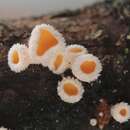pt-BR
nomes no trilho de navegação


Die Hyaloscyphaceae bilden eine Familie der Pilze innerhalb der Ordnung der Helotiales.
Die Hyaloscyphaceae bilden als Fruchtkörper kleine flache oder becherförmig Apoothecien aus. Das Excipulum, also die Struktur um den Fruchtkörper, ist weich und fleischig und besteht normalerweise aus prismatischen oder isodiametrischen Zellen. Es besitzt fast immer deutliche, manchmal ornamentierte Haare rund um die Fruchtschicht, die oft hell gefärbt ist. Die Schicht zwischen den Schläuchen besteht aus einfachen Paraphysen, die lanzettlich geformt sein können. Die Schläuche selber sind im Normalfall zylindrisch-keulig, dünnwandig und klein und haben einen amyloiden (mit Jod anfärbbaren) oder inamyloiden apikalen Ring. Die Ascosporen sind klein, oft länglich und können septiert oder unseptiert sein.
Ein Stroma wird nicht gebildet. Nebenfruchtformen sind selten, wenn vorhanden, so kommen verschieden gestaltete hyphomycetische Formen vor.
Hyaloscyphaceae sind weltweit verbreitet. Die Arten leben normalerweise saprotroph auf krautigen oder holzigen Pflanzen. Auf Lärche wächst der Lärchenkrebs (Lachnellula willkommii). Viele Arten leben spezialisiert nur auf einem Wirt, ein Hinweis auf eine endophytische Lebensweise.[1] So wurden kürzlich einige Arten innerhalb der Pflanzenwurzeln des Heidekrautgewächses Enkianthus campanulatus entdeckt, die vermutlich eine Mykorrhiza bilden.[2]
John Axel Nannfeldt beschrieb die Familie 1932.[3] Die Familie ist polyphyletisch, manche Gattungen sind ebenfallspolyphyletisch, aber oft noch sehr schlecht untersucht. Die Familie wird in nächster Zeit vermutlich aufgespalten und Han und Mitarbeiter schlugen 2014 vor, dass in der Familie Hyaloscyphaceae sensu stricto nur noch die Gattung Hyaloscypha bleiben soll. Der Tribus Lachnaeae ist ihren Untersuchungen zufolge monotypisch, die Triben Arachnopezizeae und Hyaloscypheae hingegen nicht. Eine Aufspaltung in mehrere Familien steht aber noch aus.[4] Zu der Familie der Hyaloscyphaceae sensu lato gehören zurzeit folgende Gattungen[5], unterteilt in die drei Triben Arachnopezizeae, Hyaloscypheae und Lachneae:[4]
Die Hyaloscyphaceae bilden eine Familie der Pilze innerhalb der Ordnung der Helotiales.
The Hyaloscyphaceae are a family of fungi in the Helotiales order. Species in this family have a cosmopolitan distribution, and are saprobic, growing on dead wood and other plant matter.[1]
According to the 2007 Outline of Ascomycota, the following genera are in the family Hyaloscyphaceae.[2]
Figures in brackets are approx. how many species per family.
Former genera; as accepted by Species Fungorum (2022);[3]
The Hyaloscyphaceae are a family of fungi in the Helotiales order. Species in this family have a cosmopolitan distribution, and are saprobic, growing on dead wood and other plant matter.
Hyaloscyphaceae es una familia de hongos en el orden Helotiales. Las especies en esta familia tienen una distribución cosmopolita, y son sapróbicas, creciendo sobre madera muerta u otros deshechos vegetales.[1]
Según el 2007 Outline of Ascomycota, los siguientes 69 géneros se encuentran en la familia Hyaloscyphaceae. Aquellos que son precedidos por un signo de pregunta tienen ubicación taxonómica incierta.[2]
Albotricha — Amicodisca — Antinoa — ?Arachnopeziza — Asperopilum — Austropezia — Belonidium — Betulina — Brunnipila — Bryoglossum — Calycellina — Calycina — Calyptellopsis — Capitotricha — Chrysothallus — Ciliolarina — ?Ciliosculum — Cistella — Cistellina — Clavidisculum — Dasyscyphella — Dematioscypha — ?Didonia — Dimorphotricha — Echinula — Eriopezia — Fuscolachnum — Fuscoscypha — Graddonidiscus — Hamatocanthoscypha — Hegermila — Hyalacrotes — Hyalopeziza — Hyaloscypha — Hydrocina — Hyphodiscus — Incrucipulum — Incrupila — Lachnaster — Lachnellula — Lachnum (sinónimo de Dasyscyphus) — Lasiobelonium — Microscypha — Mollisina — Neodasyscypha — Olla — Otwaya — Parachnopeziza — Perrotia — Phaeoscypha — Pithyella — Polaroscyphus — Polydesmia — Proliferodiscus — Proprioscypha — ?Protounguicularia — Psilachnum — Psilocistella — Pubigera — Rodwayella — Solenopezia — Tapesina — Trichopeziza — Unguicularia — Unguiculariella — Unguiculella — Urceolella — Velutaria — Venturiocistella
Hyaloscyphaceae es una familia de hongos en el orden Helotiales. Las especies en esta familia tienen una distribución cosmopolita, y son sapróbicas, creciendo sobre madera muerta u otros deshechos vegetales.
La famille des Hyaloscyphaceae est une famille de champignons de l’ordre des Helotiales.
Selon BioLib (10 février 2019)[2] :
Selon Catalogue of Life (10 février 2019)[3] :
Selon ITIS (10 février 2019)[4] :
Selon NCBI (10 février 2019)[5] :
La famille des Hyaloscyphaceae est une famille de champignons de l’ordre des Helotiales.
Hyaloscyphaceae is een grote familie van de Leotiomycetes, behorend tot de orde van Helotiales.
De familie Hyaloscyphaceae bestaat uit 58 geslachten en 541 soorten.
Hyaloscyphaceae is een grote familie van de Leotiomycetes, behorend tot de orde van Helotiales.
Przeźroczkowate (Hyaloscyphaceae Nannf.) – rodzina grzybów z rzędu tocznikowców (Helotiales)[1].
Hyaloscyphaceae, Helotiales, Leotiomycetidae, Leotiomycetes, Pezizomycotina, Ascomycota, Fungi [1].
Według ciągle aktualizowanej klasyfikacji Index Fungorum bazującej na Dictionary of the Fungi do rodziny tej należą[2]:
Przeźroczkowate (Hyaloscyphaceae Nannf.) – rodzina grzybów z rzędu tocznikowców (Helotiales).
Hyaloscyphaceae Nannf., 1932
Типовой родГиалосцифовые (лат. Hyaloscyphaceae) — семейство грибов, входящее в порядок Гелоциевые (Helotiales) класса Leotiomycetes.
Анаморфы известны лишь у небольшого числа представителей.
Гиалосцифовые (лат. Hyaloscyphaceae) — семейство грибов, входящее в порядок Гелоциевые (Helotiales) класса Leotiomycetes.
晶杯菌科(學名:Hyaloscyphaceae)是子囊菌門錘舌菌綱柔膜菌目的一個科,於1932年由瑞典植物學家John Axel Nannfeldt(英语:John Axel Nannfeldt)建立。截至2008年,本科包含74個屬,共933種物種[1],是柔膜菌目中最大的科[2]。本科物種營養方式多為腐生[3],子囊盤的直徑多在1毫米以下,顏色鮮豔,且邊緣與下側常有各種形狀的毛[2]。
Nannfeldt建立晶杯菌科時,將本科分為Arachnopezizeae、 Hyaloscypheae與Lachneae等三個族,其中Arachnopezizeae包含子囊盤(英语:apothecium)生長於菌絲層(subiculum)之上者,Hyaloscypheae包含子囊盤較小、有各種形狀的毛,且側絲(英语:paraphyses)為圓柱形者,Lachneae則包含子囊盤相對較大、毛表面粗糙且有隔板(英语:septa)、且側絲呈披針形者。2014年,分子種系發生學的研究結果顯示晶杯菌科並非單系群,且晶杯菌科的三個族中,只有Lachneae是單系群,子囊盤上的毛,Arachnopezizeae子囊盤下方的菌絲層都被認為並非共衍徵,而是多次獨立演化而來。因此該研究主張晶杯菌科的分類有待改動,而暫時將晶杯菌科包含的類群範圍限制在晶杯菌屬(英语:Hyaloscypha)一屬中[2]。
晶杯菌科(學名:Hyaloscyphaceae)是子囊菌門錘舌菌綱柔膜菌目的一個科,於1932年由瑞典植物學家John Axel Nannfeldt(英语:John Axel Nannfeldt)建立。截至2008年,本科包含74個屬,共933種物種,是柔膜菌目中最大的科。本科物種營養方式多為腐生,子囊盤的直徑多在1毫米以下,顏色鮮豔,且邊緣與下側常有各種形狀的毛。